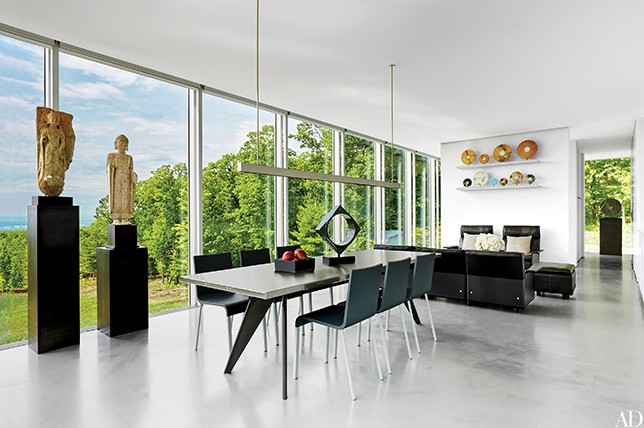Exploring the World of Architecture and Interior Design
Share this:

Architecture and interior design converge to create captivating spaces that reflect the essence of creativity and functionality. From iconic architectural styles to the latest interior design trends, this narrative is a journey through the art of crafting living environments that inspire and delight.
As we delve into the nuances of architectural styles, interior design elements, sustainable practices, and emerging trends, a world of innovation and beauty unfolds before us, offering a glimpse into the dynamic realm of architecture and interior design.
Architecture Styles
Art Deco, Modernist, Bauhaus, and many other architectural styles have left a significant mark on the built environment over the years. These styles are characterized by unique features and design elements that set them apart from one another.Key Characteristics of Popular Architectural Styles
- Art Deco: Known for its geometric shapes, vibrant colors, and decorative motifs, Art Deco emerged in the 1920s and 1930s.
- Modernist: Emphasizing simplicity, functionality, and the use of new materials like steel and glass, Modernist architecture gained popularity in the mid-20th century.
- Bauhaus: Influenced by the idea of merging art and technology, Bauhaus architecture focuses on clean lines, geometric shapes, and minimal ornamentation.
Traditional vs. Contemporary Architectural Styles
Traditional architectural styles often draw inspiration from historical designs, featuring intricate details, ornate decorations, and a sense of grandeur. In contrast, contemporary architectural styles prioritize simplicity, sustainability, and innovative use of materials.Iconic Buildings Representing Different Architectural Styles
- The Chrysler Building in New York City showcases the Art Deco style with its distinctive crown and intricate metalwork.
- The Guggenheim Museum in New York, designed by Frank Lloyd Wright, is a prime example of Modernist architecture with its organic form and use of concrete and glass.
- The Bauhaus School building in Dessau, Germany, embodies the principles of Bauhaus architecture with its functional design, flat roof, and emphasis on geometric shapes.
Interior Design Elements
Color theory, lighting, and furniture layout are crucial elements in interior design that significantly impact the overall look and feel of a space.Color Theory in Interior Design
Color theory plays a vital role in interior design as it sets the mood, creates cohesion, and enhances the visual appeal of a space. Different colors evoke different emotions and can influence the perception of a room's size and ambiance. It is essential to understand the principles of color theory, such as complementary, analogous, and monochromatic schemes, to create a harmonious and balanced environment.Importance of Lighting in Enhancing Interior Spaces
Lighting is a key element in interior design that can transform the atmosphere of a room. Proper lighting can highlight architectural features, create focal points, and improve the functionality of a space. Natural light is ideal for enhancing the overall ambiance, while artificial lighting can be used to add drama, warmth, or brightness as needed. A well-thought-out lighting plan is essential to ensure that different areas of a room are properly illuminated based on their function.Impact of Furniture Layout on Functionality
The layout of furniture in a space greatly affects its functionality and flow. Proper furniture arrangement can optimize the use of space, create designated areas for specific activities, and improve traffic flow. It is essential to consider the scale, proportion, and function of each piece of furniture to ensure that it complements the overall design and meets the needs of the occupants. The placement of furniture can also define the focal points of a room and contribute to the overall aesthetic appeal.Sustainable Architecture
Sustainable architecture focuses on creating buildings that are environmentally friendly, energy-efficient, and socially responsible. It involves using design strategies that minimize the negative impact on the environment, conserve natural resources, and promote healthy living spaces. Eco-friendly design practices are essential in addressing climate change and promoting a sustainable future.Principles of Sustainable Architecture
Sustainable architecture incorporates various principles to reduce energy consumption, minimize waste, and enhance the quality of indoor environments. Some key principles include passive solar design, energy-efficient systems, use of renewable materials, water conservation, and waste reduction strategies.Examples of Innovative Sustainable Architecture Projects
- The Edge in Amsterdam, Netherlands: Known as the greenest office building in the world, The Edge uses advanced technologies like smart lighting and energy-efficient systems to reduce energy consumption.
- Bosco Verticale in Milan, Italy: This residential complex features vertical forests that absorb CO2, produce oxygen, and provide natural insulation, contributing to a healthier urban environment.
- The Bullitt Center in Seattle, USA: A commercial office building that generates its energy from solar panels, harvests rainwater, and incorporates natural ventilation systems to achieve net-zero energy consumption.

